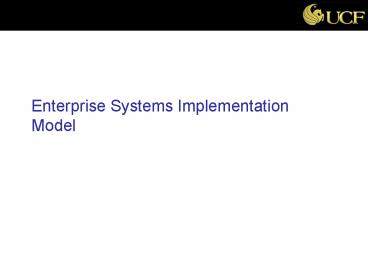Enterprise Systems Implementation Model - PowerPoint PPT Presentation
1 / 25
Title:
Enterprise Systems Implementation Model
Description:
Processes being enabled. Technology. People who will use it. Groups affected. Process ... Mt. Auburn. Factor. Present. Process Volume. Process Complexity ... – PowerPoint PPT presentation
Number of Views:67
Avg rating:3.0/5.0
Title: Enterprise Systems Implementation Model
1
Enterprise Systems Implementation Model
2
PEIT Model
- Pitfalls
- Undesirable circumstances that arise during
implementation - Implementation factors
- Characteristics that determine which pitfalls are
likely to be relevant - Strategies
- Actions that will mitigate the pitfalls
3
Pitfalls
- Inertia
- Resistance
- Mis-specification
- Misuse
- Nonuse
4
Inertia
- Inertia is the lack of progress over time on
implementation decisions and other activities,
even after all parties have agreed to proceed
with the effort. - It typically manifests itself as project delays
and cost overruns - Inertia results in preservation of the
organizational status quo
5
Resistance
- Resistance is a lack of progress over time due to
disagreement on whether the system initiative,
as proposed, is a good idea. - Like inertia, resistance manifests itself in the
form of delays - Resistance may show up as overt friction or may
be more tacit - Unlike inertia, resistance is largely a political
phenomenon
6
Mis-specification
- Mis-specification is making configuration
decisions incorrectly, resulting in an
application that works in a technical sense but
does not support the needs of the organization - The symptoms include disrupted process execution
and poor operational performance
7
Misuse
- Misuse is improper employment of a new system by
its users - Misuse includes incorrect or incomplete data
entry or other task performance that negatively
affects execution of other tasks or processes - Like mis-specification, misuse manifests itself
as disruptions and poor performance
8
Nonuse
- Nonuse is lack of adoption of a new system by its
intended users after it has been put in place - Nonuse is only possible when the technology is
discretionary when failure to use the system does
not automatically compromise other tasks or
processes which would be misuse
9
Factors
- Processes being enabled
- Technology
- People who will use it
- Groups affected
10
Process
- Volume
- Number of business processes included
- Novelty
- Degree to which the new process is different from
the previous process from the point of view of
the people affected - Complexity
- Difficulty of completely and accurately
specifying the new process using the selected
technology
11
Technology
- Templates
- Implementing best practices with minimal
customization - Tools
- Process must be entirely developed from a
generalized tool
12
People
- Discretion
- Freedom to use the technology when executing the
process - Sophistication
- Technical sophistication of users
- This includes familiarity with information
technology as well as with process interdependence
13
Groups
- Span
- The number of groups and the whether the groups
are from the same organization or more than one
firm - Core
- Whether the groups consider the process to be
core to their mission - Autonomy
- Extent to which groups have decision making
freedom with regard to the system
14
Pitfalls and Causal Factors
15
Rich-Con
16
Cisco
17
Mt. Auburn
18
Dubai Ports Authority
19
Strategies
- Level of governance
- Managerial style
- Phasing
- Scope
- Organizational preparation
20
Level of governance
- Refers to the rank of the members of the project
steering committee - High rank signals the importance of the effort to
the organization - Rank should be above the interfaces of the
groups affected by the system so decisions about
process changes, roles, responsibilities, etc.
can be made - Especially important when inertia or resistance
are likely
21
Style
- Decision-making
- Rapidly surfacing and resolving issues
- Useful when inertia, resistance or
mis-specification are likely - Consensus-building
- Focus on achieving buy-in from involved groups
and people - Useful when nonuse is likely
22
Phasing
- Project timeline including number and dates of
milestones, go-live date, big bang vs. phased
implementation
23
Preparation
- Extent of resources devoted to organizational
change efforts, training, structural changes,
etc. - Extent of preparation devoted to
non-organizational stakeholders such as suppliers
and customers
24
Scope
- Reducing scope in terms of the number of groups
or functionality involved - Adjustments may be necessary during
implementation process - Scope adjustments are usually temporary
- Opposite of scope creep
25
Pitfalls and Strategies































